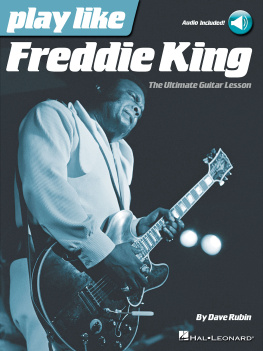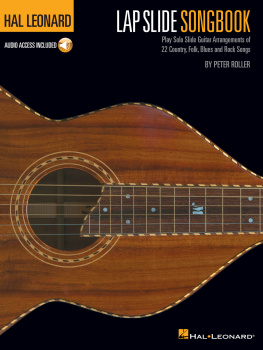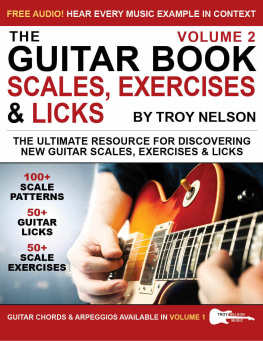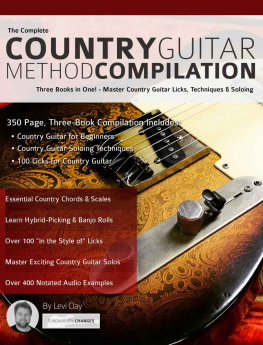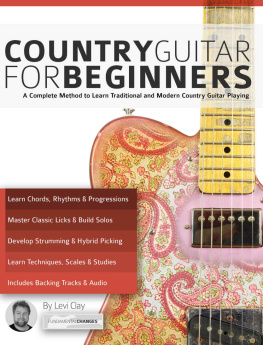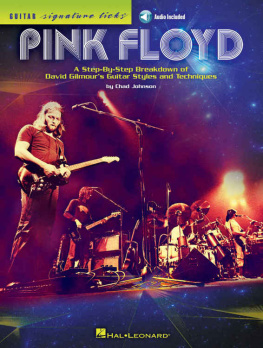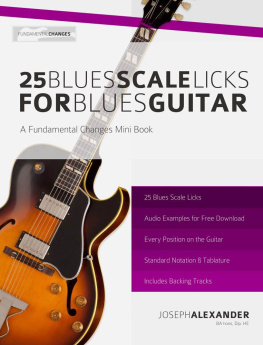Copyright 2017 Fundamental Changes Ltd.
The moral right of this author has been asserted.
All rights reserved. No part of this publication may be reproduced, stored in a retrieval system, or transmitted in any form or by any means, without the prior permission in writing from the publisher.
The publisher is not responsible for websites (or their content) that are not owned by the publisher.
Other Books from Fundamental Changes
The Complete Guide to Playing Blues Guitar Book One: Rhythm Guitar
The Complete Guide to Playing Blues Guitar Book Two: Melodic Phrasing
The Complete Guide to Playing Blues Guitar Book Three: Beyond Pentatonics
The Complete Guide to Playing Blues Guitar Compilation
The CAGED System and 100 Licks for Blues Guitar
Fundamental Changes in Jazz Guitar: The Major ii V I
Minor ii V Mastery for Jazz Guitar
Jazz Blues Soloing for Guitar
Guitar Scales in Context
Guitar Chords in Context
The First 100 Chords for Guitar
Jazz Guitar Chord Mastery
Complete Technique for Modern Guitar
Funk Guitar Mastery
The Complete Technique, Theory and Scales Compilation for Guitar
Sight Reading Mastery for Guitar
Rock Guitar Un-CAGED: The CAGED System and 100 Licks for Rock Guitar
The Practical Guide to Modern Music Theory for Guitarists
Beginners Guitar Lessons: The Essential Guide
Chord Tone Soloing for Jazz Guitar
Heavy Metal Rhythm Guitar
Heavy Metal Lead Guitar
Progressive Metal Guitar
Heavy Metal Guitar Bible
Exotic Pentatonic Soloing for Guitar
Voice Leading Jazz Guitar
The Complete Jazz Soloing Compilation
The Jazz Guitar Chords Compilation
Fingerstyle Blues Guitar
The Complete DADGAD Guitar Method
Country Guitar for Beginners
Beginner Lead Guitar Method
The Country Fingerstyle Guitar Method
Beyond Rhythm Guitar
Introduction
Music is many things to many people. Its an escape, its art, its a passion, its work, its frustration, its culture, and many more things too.
There are also many facets to learning music and as players, its easy to get caught up in the technical aspect. While technique is hugely important to your development as a player, it only prepares you for playing music, but isnt actually music in itself. Playing a chromatic scale up and down the neck isnt music, but there are several technical benefits to doing it. There are many great books out there that cover the technical side of playing guitar. Thats not what this book is about, but developing technique will be an important part of mastering the content here.
Many players get caught up in the theoretical aspect of playing music. Depending on your goals as a player, it may be useful to memorise scales, keys, chords, arpeggios, etc. But youre still not talking about real music, just the building blocks. Knowing arpeggio substitution options on dominant 7 chords isnt music, but may result in a more informed note choice when soloing.
I like to think of music as a language. You cant learn to speak a language if youve never heard it spoken. You may be a great picker and you may know the right scale to play over a song in G but thats not enough to pass as a country player! You cant just invent words or ignore things like sentence structure.
Playing music is about understanding the language. There are only twelve notes in music, but every genre treats those notes differently.
This book is presents you with an authentic vocabulary as performed by 20 of the greatest country players the genre has seen. Its about learning how real country players use the techniques and theory you may already know (ideally from my best-selling book: Country Guitar for Beginners!). Its about making you sound like a real country player.
On the other hand, Ive seen many books that just throw licks at you like thats the answer to making you a good player. I didnt want to do that here. I want this to be more than a book of 100 licks that you learn and never use.
The solution is to understand where these licks come from and how you can use them in any key and any setting. Before learning the licks, Im going to teach you how to memorise this vocabulary the way I do. Then, when youve got all these licks under your fingers, learn some solos that adapt them into new and fresh sounds. 100 licks may seem like a lot, but once you start connecting licks and mutating them to your desires, youll find them almost infinite.
Playing music isnt just about playing licks. As I sit here and write this sentence, Im not just using combinations of words that I know work. Im expressing my thoughts freely because I understand the language. The more you develop as a player, the less youll rely on things youve learned. Youll be free to play whats in your head, but youll look back and appreciate how great your phrasing is because you learned the language from the masters.
There are twenty players showcased here, with five licks given in the style of each. Thats not a lot to tell you about a player, but every single one of these musicians has a wealth of recorded music thats essential to check out. After all, thats how I developed all these licks!
If youre familiar with a few names on the list, then take the chance to check out some of the others. You never know you might find 100 more licks you want to learn! The artists have been presented alphabetically as theres no clear ramp in difficulty, some artists play things that are incredibly simple and then play something that could rip your head from your shoulders so dig in where your interest takes you.
The final piece of advice Ill give you is to internalise the sounds of these licks. Its not just about playing the notes on the page to sound like the recording. Listen to the recording 50 times till you know the lick inside out. Try singing it before playing it. As you learn the idea, focus on the notes youre expecting to hear before you play them.
This is a subject that feels a little esoteric as its quite challenging to demonstrate. Developing the ear is always our number one goal. When that ear is well developed, youll be able to put on any guitar solo, hear a lick, sing it and then play it! I know that goal seems a million miles away but a journey of 1000 miles begins with a single step!
Keep at it, and youll reach your goals in time.
Good luck!
A Note on Guitar Tone
Rather than spending hours creating unique tones for each artist, my intention was to have one basic sound that's attainable by anyone. This way, you get an idea of how you can bring the sound of each artist to your own rig and make it your own.
Aside from the Jerry Reed examples which were recorded on my Godin Multiac Nylon String, every example was recorded using a relatively cheap Mexican Fender Road-Worn Telecaster (with Joe Barden's Danny Gatton pickup set).
Amp-wise, I used a profile of a Dr Z MAZ 18NR on my Kemper Power Rack. While that's not a cheap piece of kit, the idea was to replicate a really great clean-sounding amp that would drive just a little bit when hit hard. Any Vox-style amp will to get you in the ballpark. However, if you want my exact tone, it's available on the official Dr website. Recording the audio for this book wasn't about having a million-dollar tone, it was about creating something that could be accessible to anyone.


